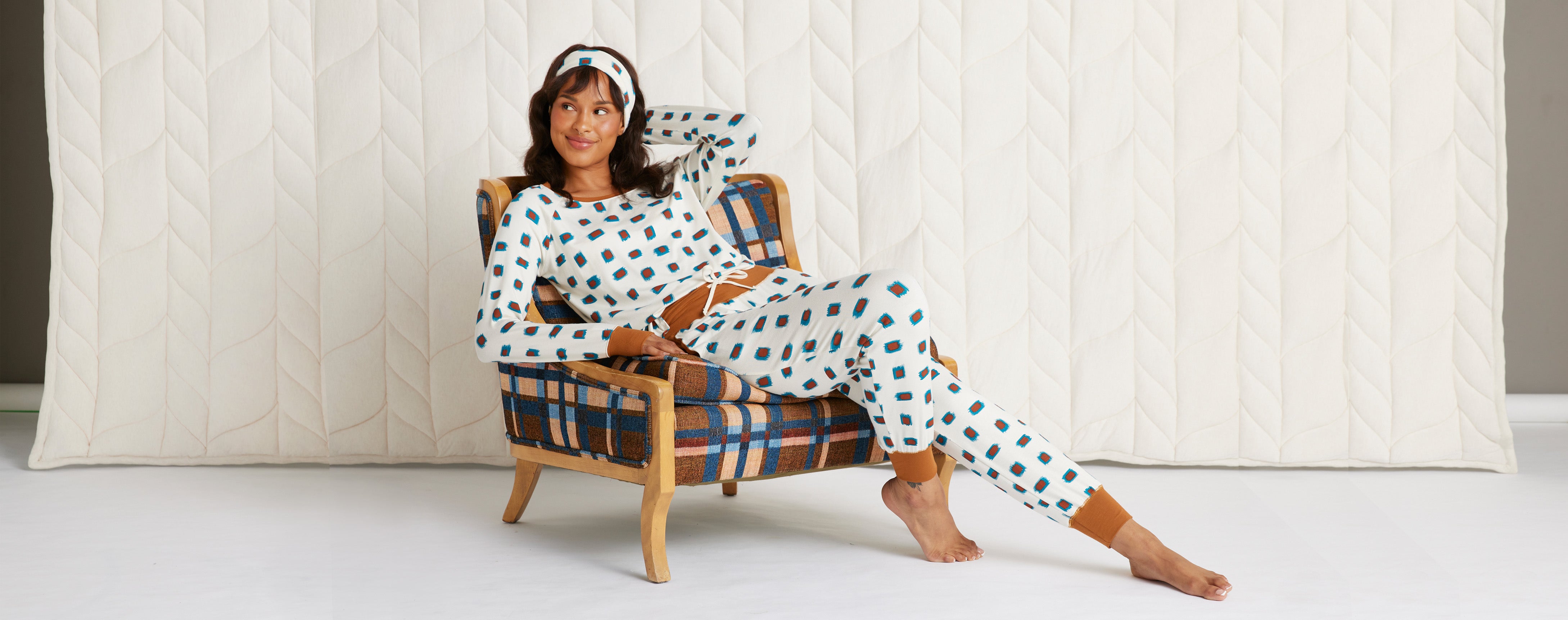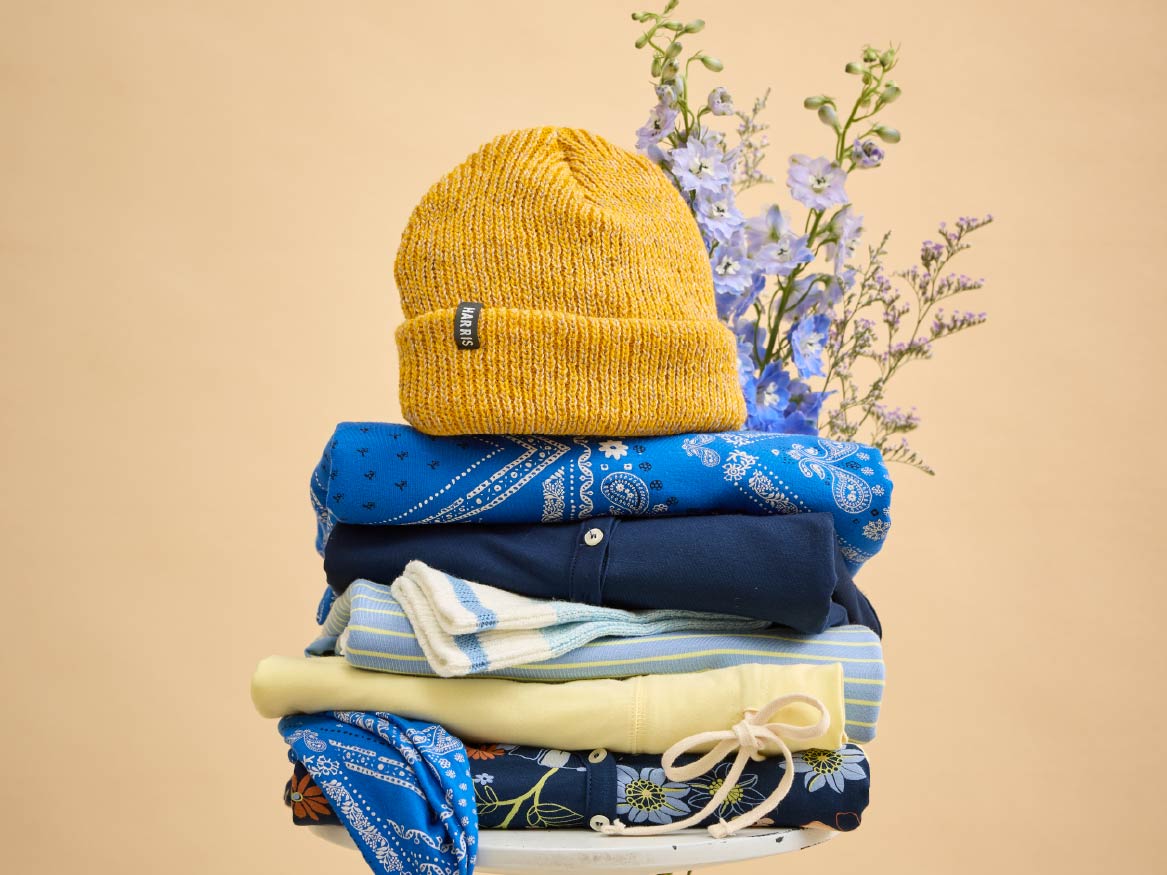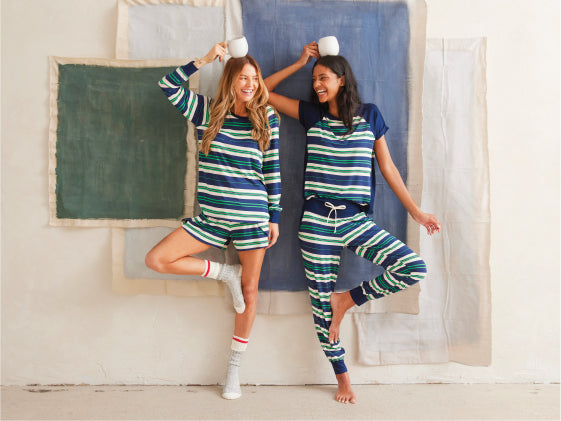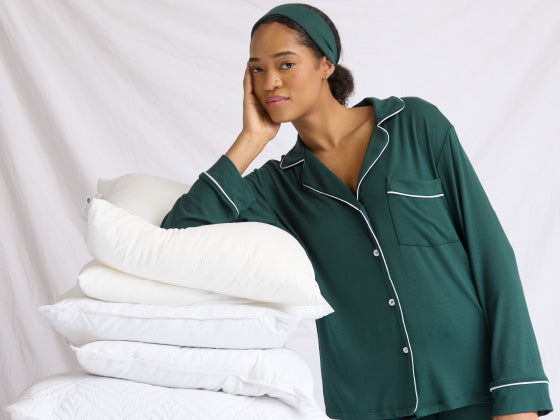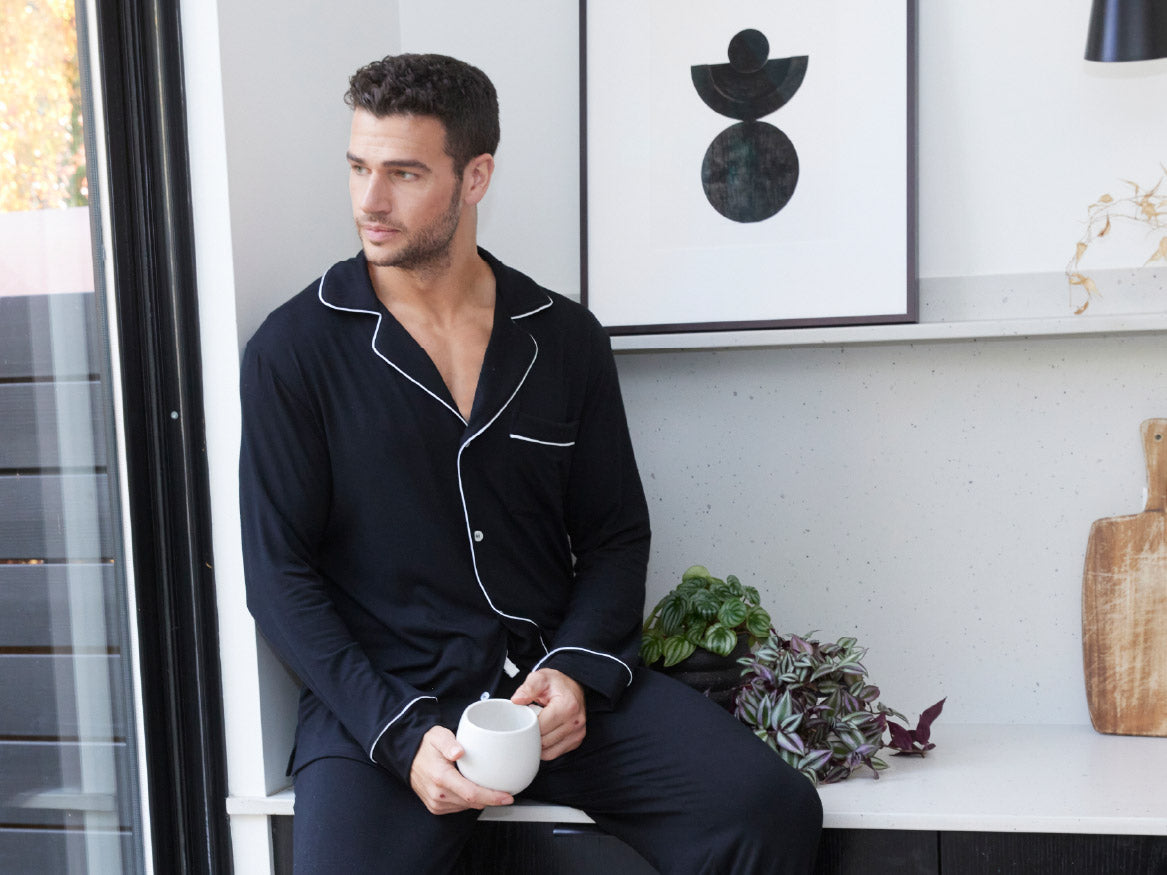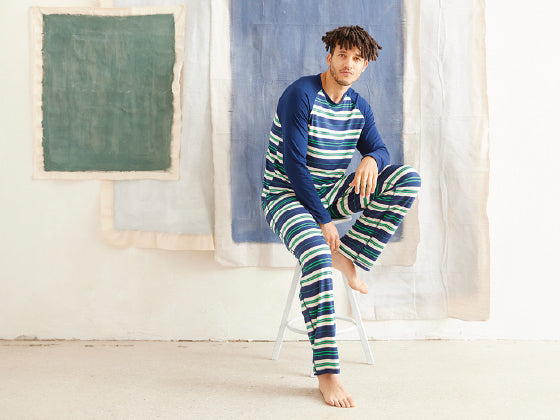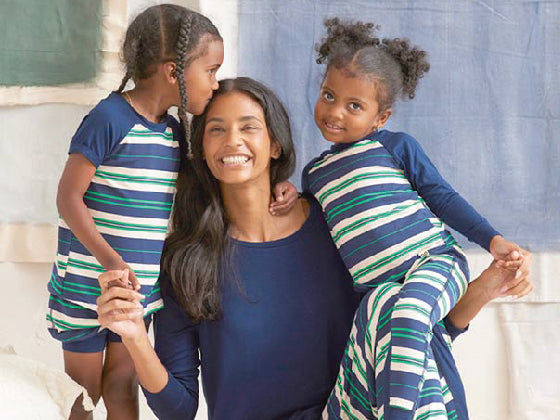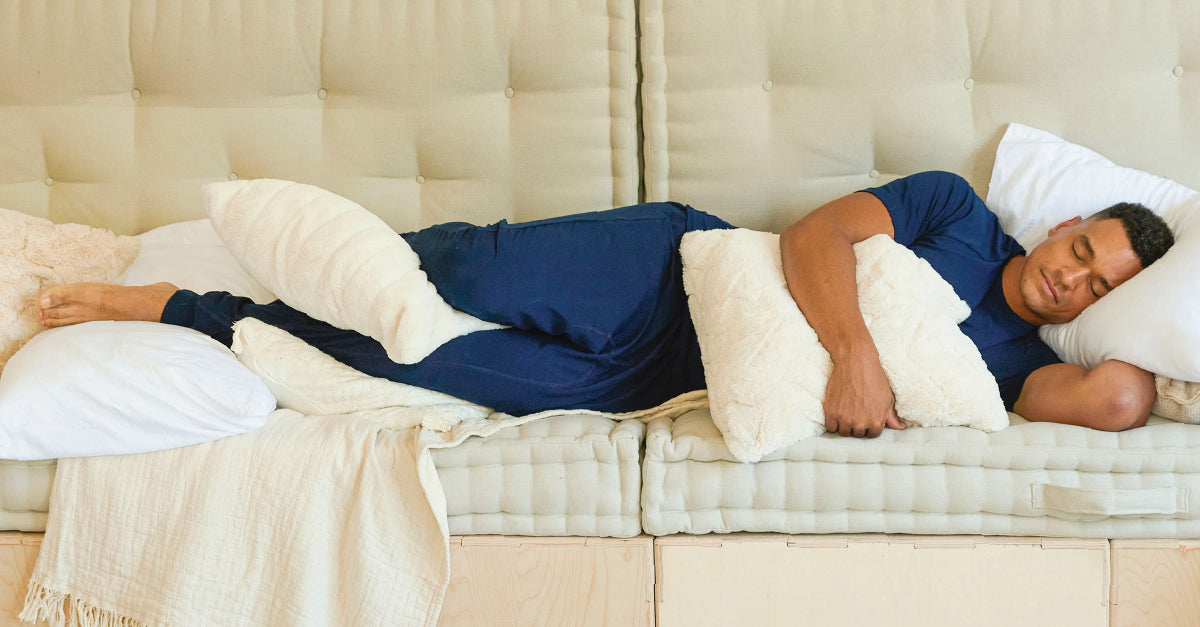This Is J uses a range of high quality, proprietary fabric blends to make our clothing, loungewear and pajamas, but the fabric we're most often asked about is bamboo viscose. In fact, our bamboo pajamas are the most sought after items in our collection!
But a lot of different companies claim to offer products made from bamboo, and not all are equal. So let's look at the fascinating world of bamboo materials, and see what makes them so special.
What is Viscose from Bamboo Fabric?
Let's start with some terminology, as you'll hear a lot of different terms for fabrics made from bamboo. While some of the differences are merely regional, others refer to different manufacturing and composition standards - so it's important to know what you're buying.
The terms you'll most commonly hear to describe fabrics made from bamboo are:
-
Bamboo
-
Bamboo Viscose
-
Bamboo Rayon
-
Artificial Silk
While all four terms are often used synonymously, they are not all technically the same. Let's dive into it:
Bamboo

Bamboo is very simply the catch-all name for a family of plants, almost all of which are fast-growing, evergreen perennials found predominantly in Southeast Asia.
Bamboo fabric can refer to any that's made partially or wholly from bamboo plants; but for legal reasons, producers and companies in most countries must specify if their textiles are made entirely from bamboo, or if they blend it with something else. They must also specify how their textile is created from the bamboo plant, as many utilize a synthetic method to create usable fibres.
It is important to follow labelling and advertising rules in properly labelling fabric made from Bamboo. In Canada this means using the proper name of Viscose from Bamboo or Rayon from Bamboo.
Viscose from Bamboo
Viscose from Bamboo - sometime referred to as bamboo viscose and viscose bamboo - is a term used to describe how a fabric is made from bamboo. Literally, "viscose" comes from the word "viscous", meaning a sticky substance; in the case of bamboo viscose, this sticky substance is the plant cellulose that comes from bamboo, which is used to create semi-synthetic fibres.
Many other types of plant matter can be used to make fibres via a similar process, which is why the term "viscose" is not specific to bamboo-related products. Other fabrics may contain the word viscose, without having anything to do with bamboo. Viscose fabrics are literally everywhere!
Rayon from Bamboo
It's a similar story with rayon from bamboo, sometimes referred to as bamboo rayon. Rayon and viscose essentially mean the same thing - creating a semi-synthetic fibre from plant matter. So why are the two different terms?
This is actually a geographical variation; "rayon" is commonly used in the U.S., while "viscose" is a more popular term across the rest of the world. But again, the term rayon does not itself have anything to do with the raw material; it simply refers to the manufacturing process. Some fabrics may not even say which plant they're made from - it's not unusual to find textiles labelled as simply "rayon" or "viscose". And viscose rayon is just a repetition of the same thing! But rayon from bamboo is a man made process specifically made from bamboo.
Artificial Silk
Lastly, artificial silk is what rayon used to be called, and sometimes still is in certain parts of the world. This was more of a marketing decision than related to anything technical, as rayon/viscose has a silky finish and is much cheaper than actual silk.
If you hear the term "artificial silk", it probably means a basic rayon/viscose fabric, rather than anything to do with bamboo - unless the fabric is specifically labelled as containing it.

How is Fabric Made from Bamboo?
So now we know what we're talking about, how is viscose from bamboo fabric made?
1. Growing Bamboo
First of all, bamboo has to be grown. As one of the fastest growing plants on the planet, this is much less intensive and more sustainable than growing many other plant types.
Any bamboo can be used to create bamboo fibers, but some producers utilize organic bamboo so they can make organic materials.

2. Extracting Cellulose
Once grown (which usually takes about four years), the bamboo must be harvested, and the wood cellulose extracted. This is done by crushing the plants (stalks and leaves) into a wood pulp.
3. Creating Bamboo Pulp
The crushed plant matter is then soaked to dissolve the cellulose . It is ripened, treated and then dissolved make it thick and viscous.
4. Spinning to Create Fibres

This thick and viscous substance can then be spun through a spinneret to create fibres. As the substance extrudes the spinneret, it's processed to create regenerated cellulose fibers.
5. Cutting and Drying into Threads

The resulting fibres are washed, bleached, dried and cut to create threads, which are then spun into yarn. After this, textiles can be made from them, just as with any other type of fabric.
A Word on Bamboo Processing
A lot of people are drawn to bamboo because of its eco credentials or a sense that it's all natural. So learning that it's considered a manmade fibre due to it's rayon process or cellulose processing may come as a surprise.
Sodium hydroxide and carbon disulfide are both used in the production process; the former is non-toxic and widely used in cooking, while the latter can only be harmful in extremely high concentration - and it breaks down when in contact with natural elements. So neither should be of particular concern.
In terms of sustainability, many manufacturers use a closed-loop system which reuses the otherwise wasted materials from the processing time and again. This is both cheaper and more environmentally friendly.
Bamboo Lyocell
Another eco-friendly bamboo fabric is Bamboo Lyocell. This is the name given to bamboo fabric created using an efficient manufacturing process that relies on non-toxic solvents.
As with rayon/viscose, lyocell in itself does not refer to the raw material, but rather the process, so other plants can create lyocell materials. Bamboo lyocell is can commonly be found in luxurious bamboo bed sheets.
Bamboo Linen

Bamboo linen is an extremely eco-friendly and sustainable form of bamboo fabric.
Especially when choosing plants with an organic growing cycle which will ensure no unwanted chemicals are used in the growth and harvesting of raw materials.
Creating bamboo linen uses a mechanical process to create bamboo fibres from the bamboo plant, in place of the cellulose process mentioned above. It should be noted that this mechanical process is significantly more labour-intensive and expensive than the cellulose process, but it does produce bamboo fabric in the most eco-friendly and sustainable way. The textiles made via this process are known as "bamboo linen" and are a coarser type of fabric suited well for home goods, drapes, and upholstery.
What Are the Benefits of Bamboo Fabric?
So why go to all this trouble to make different types of bamboo fabric? There are plenty of reasons!
Eco-Friendly and Sustainable Crops
As we mentioned above, bamboo crops grow very rapidly, and also self-generate, making it a sustainable raw material that replenishes itself. Bamboo groves need very few resources to flourish - minimal water and nutrients - meaning they do not deplete the soil or fresh water reserves. Pesticides and fertilizers are usually unnecessary, and bamboo generates more oxygen than most other plant types. And its growth time means that it can be harvested repeatedly, without the risk of deforestation, which helps to protect ecosystems and wildlife.
So compared to many other raw materials, bamboo is extremely environmentally-friendly, with a very small carbon footprint and can be a great eco friendly alternative to other fabrics depending on the type of bamboo fabric and its processing.
Naturally Antimicrobial & Moisture Wicking
Compared to many other materials, bamboo is highly resistant to bacteria. This, when coupled with its ability to wick moisture, means it stays cleaner and fresher for longer.
Bamboo bedding needs fewer washes, bamboo clothing prevents sweat accumulation, and bamboo fabrics in general are more odour-resistant than their competitors. This is one of the reasons bamboo textiles make such great workout clothes and sleepwear. It's also why this fabric is popular with those who suffer from sensitive skin or allergies.
And as an added bonus: fewer washes means less water used, which is also eco-friendly!
Silky and Comfortable
Bamboo fabric has very long fibres - much longer than you'd find in other textiles - and for this reason it has a silky, smooth finish that many find luxurious. It's this finish that makes bamboo viscose clothing so popular, and why so many luxury bed sheets are made from this amazing plant! It also accepts dyes extremely well, increasing its versatility for everyday use.
Bamboo fibres can also be woven into fabrics with very high thread counts, resulting in material that is both thin and smooth, without sacrificing tensility.
Low Maintenance
Because of these long fibres, bamboo viscose fabric has less pilling than other types of material. This is because friction between fibres is what causes pilling.
This is just one aspect of its low maintenance; another is that unlike many other luxurious fabrics - in particular expensive silk fabrics - viscose from bamboo is machine washable. There is no need to go to the dry cleaner!
Breathable
Lastly, because viscose from bamboo has thousands of tiny gaps, it is a very breathable material. This is another aspect of why it's so popular for loungewear and workout clothes - your skin can breathe naturally.

It is important to note that the man made process of turning bamboo into a cellulose fibre can remove many of the original attributes found in bamboo. Always ask before you buy to ensure that the products you are buying can sustain these claims through independent testing.
Bamboo Viscose vs. Other Fabrics
Given all of the benefits of bamboo viscose (which, remember, means exactly the same thing as bamboo rayon), you may be wondering why anyone would choose anything else! It's important to remember that different types of fabric are useful in different situations, and not everything can be used everywhere.
For example, polyester sheets may seem like an unusual choice when bamboo sheets are available; but polyester is a highly durable, lightweight material that is less absorbent than bamboo. This makes polyester sheets more suitable for high-turnover, budget bedding.
Cotton is multi-purpose, cheap and can be made into both thick and thin fabrics; it's also very easy to wash cotton fabrics. But cotton uses far more water in its production, takes longer to grow, and erodes the soil - so while very versatile and commonly used (especially in sleepwear), its eco credentials are lacking.
We could run through every type of fabric known to man, but the long and short of it is that your intended use, budget and restraints dictate which is the best fabric for you, and how viscose from bamboo compares to other rayon fabrics for your needs.
Pure Bamboo vs. Bamboo Blends
Another nuance you need to be aware of is the percentage of bamboo in viscose from bamboo, rayon from bamboo and other types of bamboo fabric.
Not every textile made from bamboo contains 100% bamboo; many companies blend bamboo with something else - meaning they combine fibres from other materials with bamboo fibres to make a hybrid that offers the benefits of bamboo alongside benefits of other materials, such as spandex, cotton or polyester.
There are some pros and cons of bamboo blends versus pure bamboo fabric. For one, bamboo blends can be much cheaper than pure bamboo clothing (depending on the content split). By combining bamboo fabric with another type of fabric, manufacturers can create new materials that leverage multiple benefits, some of which may not be available with pure bamboo fabric. Such as adding controlled stretch to the fabric by adding spandex.
The best advice is to always check the label of what you're buying. If a fabric is a blend, it should say so, and provide the breakdown of its composition. While if it is made from only bamboo, it will declare itself as 100% bamboo in origin. Remember to compare between blends too, as one bamboo blend may not stack up against other bamboo fabrics.
Downsides of Bamboo Fabric
Nothing is entirely perfect though, so it's worth mentioning some of the downsides of using bamboo in textiles.
One of the major criticisms it receives is the fact that it needs to be shipped. Almost all bamboo in the world must be transported from Southeast Asia, where it is grown, to wherever it is used - which adds significantly to its overall carbon footprint.

It's also worth mentioning that the bamboo viscose process is fairly energy intensive, and produces carbon dioxide. And as we mentioned above, not every bamboo textile - or bamboo grower - is equal. Different legislation in different countries can mean some fabrics originate from crops that have been exposed to pesticides, or are made with processes that are harmful to the environment.
All of this means that the sustainability of bamboo material depends on where the raw material was grown and how it was processed into usable fabric.
As consumers, it behooves all of us to be aware of these issues, especially as rayon and viscose bamboo becomes more and more popular for use in the textile industry.
The Rise in Sustainable Fashion and Homeware

While the demand for sustainable materials is growing, cheaper fabrics still dominate the fashion and homeware markets. This is slowly changing though; by 2027, projections indicate that the ethical fashion market will be worth USD 11.2 billion.
FAQ
Is bamboo an environmentally-friendly material?
That depends on where and how it is grown, how it is processed, and its final use. The bamboo plant is an extremely sustainable raw material, but only organic bamboo can boast of being chemical-free, and only 100% bamboo products utilize bamboo cellulose only.
What is the difference between bamboo viscose and bamboo rayon?
Nothing! It's simply a geographical variation in terminology. The same is true for viscose from bamboo and viscose from rayon. And the term viscose rayon is just repetitive.
Is bamboo viscose the same as 100% bamboo?
Not necessarily. Bamboo viscose compares to bamboo rayon synonymously. The difference is simply the process used to create the bamboo material from bamboo cellulose. Many bamboo rayon and bamboo viscose products are blends.
You can determine if a bamboo rayon product is 100% bamboo by looking at the fabric label.
Is bamboo viscose and bamboo rayon natural or synthetic?
A bamboo plant is a natural raw material, but it must be processed to create regenerated cellulose fibres that can then make semi-synthetic fibre, that can be used to make rayon fabric. This puts bamboo rayon in the awkward position of being semi-synthetic. It is more natural than a synthetic fabric derived from non-organic matter, but it is not all-natural due to its man made process.
Is viscose from bamboo good for skin?
Yes. Those with sensitive skin can benefit from the silky soft texture of superior bamboo materials, which are moisture wicking, antimicrobial, and present less friction than other options. It is important to understand the process the bamboo clothing you are buying is made from
Bamboo viscose clothing is a great, super soft option if you have easily irritated skin, and bamboo bed sheets offer many benefits. Using bamboo makes sheets extra breathable, and unlike cotton, most pure bamboo sheets stay clean a lot longer.
Is bamboo rayon good for hot sleepers?
Bamboo rayon, also known as bamboo viscose makes great bedding, especially if you struggle with temperature regulation. The silky smooth feeling the rayon and viscose process creates means rayon and viscose bamboo is extremely comfortable, and boasts the many benefits of bamboo fibers. Typically bamboo PJs have the feeling of luxurious fabric, are moisture wicking, and feels incredible against your skin. Bamboo pajamas/pyjamas come in many forms though; to find the perfect pair of bamboo pjs that suit your needs, remember to look at the composition of the fabric and where the manufacturing of the product takes place.
Does bamboo viscose make good bamboo clothing and sheets?
The silky feeling of viscose and rayon fabrics feel soft and luxurious against the skin and often drape gently for a comfortable fit. Bamboo viscose is often used in in the manufacturing of loungewear for these reasons.
Typical bamboo sheets have the feeling of luxurious fabric, are moisture wicking, and pure bamboo feels incredible to lie on. Bamboo sheets come in many forms though; to find the set of bamboo sheets that suit your needs, remember to look at the fabric content and whether it is a bamboo blend when comparing against other sheets.
